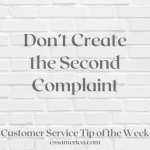
Okay, so I’m going to get in trouble with some of you for this one – but it’s an idea to consider.
When face-to-face with that co-worker or customer, sometimes a gentle touch on the shoulder or arm is appropriate or helpful. Studies have shown that hugs can create chemical reactions that can aid one’s health, feelings, and even healing. I’m no clinician, but this point isn’t clinical. It’s personal. Sometimes it’s difficult to connect with people if there’s an invisible wall not allowing any contact. It can be tough to convey we care purely with words when we’re not willing to extend our hand to the other.
It’s hard to be empathetic during those conversations where pain and hurt are involved if we keep an artificial barrier between us.
Now we don’t want to become the grocery store chain that got sued by their check-out clerks because management encouraged the clerks to make eye contact with customers and smile (some customers felt that the clerks were flirting, which led to…uh…awkward exchanges).
We don’t expect you to act like the French, where a Ken Cooper study once showed that French patrons at outdoor Paris cafés casually touched each other 110 times per hour. But it also means we don’t have to be like some Londoners (0 touches per hour) or some Floridians (2 touches per hour).
The point is that sometimes caring for others requires that we do more than check their vital signs. It means that we have to do more than say “I care.” It means that we have to do more than smile or nod. Sometimes to show we care, to go beyond “professional” to “human,” we have to provide that human touch.
It’s a hand on the arm, a gentle pat on the shoulder, shaking the hand, or placing a hand on the back.
Do what’s appropriate and what you are comfortable doing – but be willing to do something. Don’t make the short distance that you stand from another person seem infinite…or infinitely impersonal.
Bridge the gap with the human touch.
Signup for FREE Tips! Contact Us More Resources for You Visit Our Home Page























